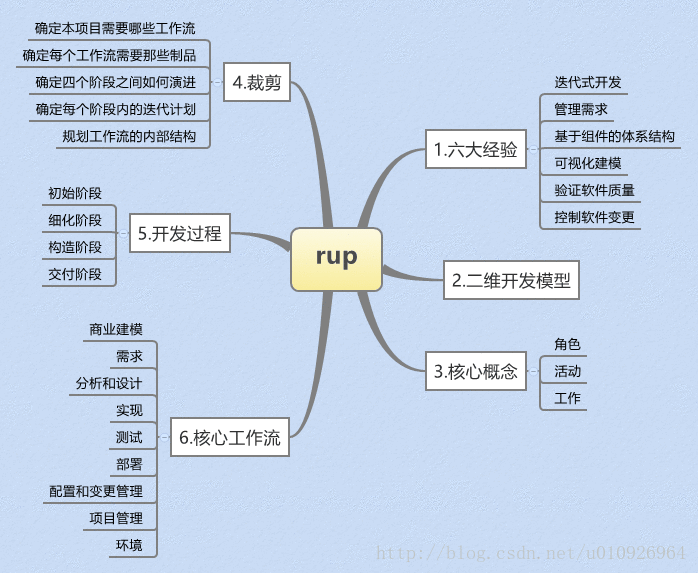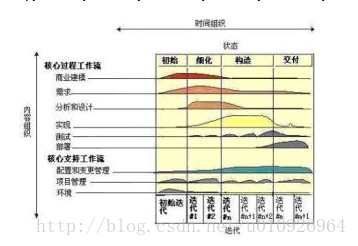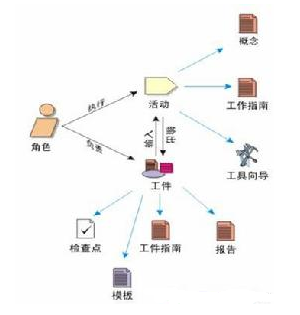Unified software development process - RUP
RUP (rational unified process) is an object-oriented and network-based program development methodology. It is a method based on object-oriented methods. RUP adheres to a use-case-driven, architecture-centered, iterative and incremental development method.
Let’s briefly introduce RUP based on the mind map:

1. Six experiences
## 1) Iterative development
Each stage in RUP can be further decomposed into iterations. An iteration is a complete development cycle. Each cycle can produce an executable file. Each cycle is an incremental development until the final product is formed. Iterative development allows requirements to change during each iteration, and the understanding of the problem is deepened through continuous refinement. Iterative development not only reduces risks, but also allows the end of each iteration to boost team morale.
2) Management requirements
RUP describes how to extract, organize and document the functions and constraints of the system, use cases and scripts The use of has proven to be an effective method of capturing requirements.
3) Component-based architecture
An architecture based on independent, replaceable, modular components helps manage complex performance and improve usage. RUP describes how to design a software architecture that is flexible, adaptable to change, easy to understand, and conducive to reuse.
4) Visual modeling
RUP is often the same as UML is linked together to establish a visual model of the software system to help people improve their ability to manage software complexity. RUP tells us how to visually model the software system and obtain information about the architecture and the structure and behavior of the components.
5) Verify software quality
In RUP SoftwareQuality assessment is no longer a separate activity performed after the fact or by a separate team, but is all activities built into the process. This way, defects in the software can be discovered early, software quality can be improved, and software costs can be saved.
6) Control software changes
If there is no strict control and coordination in iterative development, the entire software development process will quickly fall into chaos Among them, RUP describes how to control, track, monitor, modify products, and isolate changes from other workspaces to establish a safe workspace for each developer.
2. Two-dimensional development model
RUPSoftware DevelopmentLifeCycle is a two Dimension’s software development model. The horizontal axis is organized through time, which is the life cycle characteristic of the process unfolding, reflecting the dynamic structure of the development process. The terms used to describe it mainly include cycle, stage, IterationandMilestone; The vertical axis is organized by content into natural logical activities, reflecting the static structure of the development process. The terms used to describe it mainly include Activities, products, workers and workflows. As shown in the picture:

##3. Core concepts
The core concepts defined in RUP mainly include roles, activities and work:
Role: describes the behavior of a person or a group and responsibilities. RUP pre-defines many roles. Activity: It is an independent unit of work with a clear purpose.
Artifact: It is a piece of information generated, created or modified by an activity.

4. Cropping
RUP is a general process template that contains many development guides, products, and role descriptions involved in the development process. Because it is very large, RUP is used for specific development organizations and projects. Cutting is also required, that is, RUP needs to be configured. RUP is like a meta-process. Many different development processes can be obtained by tailoring RUP. These Software Development processes can be regarded as specific instances of RUP. ##. RUP tailoring can be divided into five steps:
1) Determine whichworkflows are needed for this project.
2) Determine which artifacts are required for eachworkflow.
3) Determine how to evolve between the 4 stages. Determining the evolution between stages should be based on the principle of risk control. Determine whichworkflows are required in each stage, to what extent each workflow is executed, what products are there, and how long each product is completed. To what extent.
4) Determine the iteration plan within each stage. Plan the content to be developed in each iteration of the 4 phases of RUP. 5) Plan workflow internal structure. WorkflowInvolves roles, activities and products. Its complexity is related to the size of the project, that is, the number of roles. Finally, plan the internal structure of the workflow, usually given in the form of an activity diagram. 5. Development process # in RUP ##Software life cycle is broken down into four sequential phases in time, namely: initial phase, refinement phase, construction phase and delivery phase. Perform an evaluation at the end of each stage to determine whether the goals of this stage have been met. If the evaluation results are satisfactory, the project can be allowed to move to the next stage. ## 1)Initial stage The goal of the initial phase is to establish the business case for the system and determine the boundaries of the project. To achieve this goal it is necessary to identify all external entities that interact with the system and define the characteristics of the interactions at a high level. This stage is of very important significance. What is focused on at this stage is the main risks in the business and requirements of the entire project. For development projects based on legacy systems, the initial phase may be short. 2)Refining stage ##The goal of the refinement phase is to analyze the problem area, establish a sound system architecture foundation, and compileprojectplan, eliminate the highest risk elements of the project. To achieve this, decisions about the architecture must be made based on an understanding of the entire system, including its scope, primary functionality, and non-functionalities such as performance need. At the same time, establish a supporting environment for the project, including creating development cases, creating templates, guidelines and preparing tools. 3)Construction phase ## During the build phase, all remaining artifacts and application functions Developed and integrated into a product, all functionality is tested in detail. The build phase is a manufacturing process in the sense that the focus is on managing resources and controlling operations to optimize cost, schedule, and quality. 4)Delivery phase ##The focus of the delivery phase is to ensure that the software is available to end users. The delivery phase can span several iterations and includes testing the product in preparation for release, with minor adjustments based on user feedback. At this point in the lifecycle, user feedback should focus primarily on product tuning, setup, installation, and usability issues, and all major structural issues should already be The early stages of the project life cycle are addressed. 6. Core workflow ## There are 9 core workflows in RUP, divided into 6 core process workflows and 3 core support workflows. These workflows are accessed multiple times throughout the lifecycle. The nine core workflows are used in rotation throughout the project, repeated with varying emphasis and intensity in each iteration. 1)Business Modeling ##Business ModelingWorkflowDescribes how to develop an idea for a new target organization and based on this idea in the businessUse Case Model Define the organization's processes, roles and responsibilities in the business object model. 2) Requirements ##RequirementsWorkflowThe goal is to describe what the system should do and to get developers and users to agree on this description. In order to achieve this goal, the required functions and constraints must be extracted, organized, and documented; the most important thing is to understand the definition and scope of the problem solved by the system. Analysis and Design ##Analysis and DesignWorkflowWillRequirementsTranslate into the design of future systems, develop a robust structure for the system and adjust the design to match the implementation environment and optimize its performance. The result of analysis design is a design model and an optional analysis model. The design model is an abstraction of the source code, consisting of design classes and some descriptions. Design classes are organized into design packages and design subsystems with good interfaces, and descriptions reflect how the objects of the class work togetherimplementuse cases function. Design activities are centered on Architecture Design. The architecture is expressed by several structural views. The structural view is an abstraction and simplification of the entire design. Some details are omitted in this view, making important The characteristics are reflected more clearly. Architecture is not only a medium for good design models, but also improves the quality of the models created during system development. 4) Implementation ##The purpose of implementing workflow includes defining the organizational structure of the code in the form of hierarchical subsystems. Implement classes and objects in the form of componentsTest and integrate the developed components as units The result produced by a single developer (or group) into an executable system. ## 5) TestingWorkflowTo verify the interaction between objects, verifysoftware Correct integration of all components in , verification that all requirements have been correctly implemented, identification and confirmation of defects before software deployment raised and processed. RUP proposes an iterative approach, which means testing throughout the project to detect defects as early as possible, fundamentally reducing the cost of modifying defects. Testing is similar to a three-dimensional model and is conducted from reliability, functionality and system performance. ## 6) Deployment DeploymentThe purpose of the workflow is to successfully generate the version and SoftwareDistributed to end users. Deployment WorkflowDescribes those activities related to ensuring that the software product is available to end users, including: software packaging, software generation Products other than itself, installing software, and providing assistance to users. 7)Configuration and Change Management ##Configuration and Change ManagementWorkflowDescribes how to control a large number of products in a project composed of multiple members. Configuration and Change ManagementWorkflow Provides guidelines for managing multiple variants in an evolving system, tracking Software Version. The workflow describes how to manage parallel development, distributed development, and how to automatically create projects. It also explains how to maintain audit records on the reasons, time, and personnel for product modifications. 8)Project Management ##Software Project Management Balance various potentially conflicting goals, manage risks, overcome various constraints and successfully deliver products that satisfy users. 9) Environment ##The purpose of the environment workflow is to provide the software development environment## to the software development organization #, including procedures and tools. Environment Workflow focuses on the activities required to configure the project process. It also supports the activities of developing project specifications, providing a step-by-step guide and describing how to implement the process in the organization. . The above is the content of the unified software development process-RUP. For more related content, please pay attention to the PHP Chinese website (www .php.cn)! # #

Hot AI Tools

Undresser.AI Undress
AI-powered app for creating realistic nude photos

AI Clothes Remover
Online AI tool for removing clothes from photos.

Undress AI Tool
Undress images for free

Clothoff.io
AI clothes remover

AI Hentai Generator
Generate AI Hentai for free.

Hot Article

Hot Tools

Notepad++7.3.1
Easy-to-use and free code editor

SublimeText3 Chinese version
Chinese version, very easy to use

Zend Studio 13.0.1
Powerful PHP integrated development environment

Dreamweaver CS6
Visual web development tools

SublimeText3 Mac version
God-level code editing software (SublimeText3)

Hot Topics
 1381
1381
 52
52
 Transformative Trend: Generative Artificial Intelligence and Its Impact on Software Development
Feb 26, 2024 pm 10:28 PM
Transformative Trend: Generative Artificial Intelligence and Its Impact on Software Development
Feb 26, 2024 pm 10:28 PM
The rise of artificial intelligence is driving the rapid development of software development. This powerful technology has the potential to revolutionize the way we build software, with far-reaching impacts on every aspect of design, development, testing and deployment. For companies trying to enter the field of dynamic software development, the emergence of generative artificial intelligence technology provides them with unprecedented development opportunities. By incorporating this cutting-edge technology into their development processes, companies can significantly increase production efficiency, shorten product time to market, and launch high-quality software products that stand out in the fiercely competitive digital market. According to a McKinsey report, it is predicted that the generative artificial intelligence market size is expected to reach US$4.4 trillion by 2031. This forecast not only reflects a trend, but also shows the technology and business landscape.
 Artificial Intelligence Applications in Software Development: Automation and Optimization
Sep 02, 2023 pm 01:53 PM
Artificial Intelligence Applications in Software Development: Automation and Optimization
Sep 02, 2023 pm 01:53 PM
As a cutting-edge technology, artificial intelligence (AI) is showing great potential in various fields. In the field of software development, the application of artificial intelligence has also attracted widespread attention. From automating tasks to code optimization, AI brings many innovative ways for developers to increase efficiency, quality, and creativity. This article will explore the application of artificial intelligence in software development, focusing on the development of automation and optimization. Automation tasks 1. Code generation By learning existing code bases, artificial intelligence can automatically generate code snippets or even complete modules. This is very helpful for developers to quickly create basic frameworks, saving time and effort. For example, some AI tools can generate boilerplate code based on requirements, allowing developers to get to work faster2
 Ten ways generative AI will change software development
Mar 11, 2024 pm 12:10 PM
Ten ways generative AI will change software development
Mar 11, 2024 pm 12:10 PM
Translator | Reviewed by Chen Jun | Chonglou In the 1990s, when people mentioned software programming, it usually meant choosing an editor, checking the code into the CVS or SVN code base, and then compiling the code into an executable file. Corresponding integrated development environments (IDEs) such as Eclipse and Visual Studio can integrate programming, development, documentation, construction, testing, deployment and other steps into a complete software development life cycle (SDLC), thus improving the work of developers. efficiency. In recent years, popular cloud computing and DevSecOps automation tools have improved developers' comprehensive capabilities, making it easier for more enterprises to develop, deploy and maintain software applications. Today, generative AI is the next generation development
 Five AI tools every software developer should try
Apr 13, 2023 pm 12:10 PM
Five AI tools every software developer should try
Apr 13, 2023 pm 12:10 PM
Artificial intelligence is increasingly penetrating into our lives and work, and the same is true for software development activities. Some relatively fixed models are being replaced by low-code and artificial intelligence. More and more attention is being paid to using AI to improve delivery efficiency. What this article describes The five tools mentioned can help us in daily development work, so you might as well try and experience them. 1. Tabnine category: AI code completion tool. Website: tabnine.comVSCode Plugin: bit.ly/3QTvC8cTabnine makes developers more productive by automatically completing their code. Smart code completion saves a lot of time. As you type, Tabnine predicts and builds
 The important role of Go language in software development
Mar 29, 2024 am 09:21 AM
The important role of Go language in software development
Mar 29, 2024 am 09:21 AM
Go language (also known as Golang) is a programming language developed by Google. It has attracted much attention since its inception. Its simplicity, efficiency, and strong concurrency make it play an increasingly important role in software development. . This article will explore the importance of Go language in software development and analyze it with specific code examples. 1. Concurrent programming Go language inherently supports concurrent programming, and its goroutine and channel mechanisms make concurrent programming very simple. Goroutine is provided by Go language
 Revealing the most promising employment fields in Python programming
Sep 08, 2023 pm 12:37 PM
Revealing the most promising employment fields in Python programming
Sep 08, 2023 pm 12:37 PM
Revealing the most promising employment areas in Python programming Python is a high-level programming language that is easy to learn, powerful and widely used, making it one of the most popular programming languages at present. The powerful functions of Python make it widely used in various industries. Therefore, choosing Python as a programming language for career development is a wise choice. This article will highlight the most promising employment areas in Python programming and provide corresponding code examples. Data Science and Machine Learning With Big Numbers
 The role Golang plays in modern software development and its importance
Mar 05, 2024 pm 04:12 PM
The role Golang plays in modern software development and its importance
Mar 05, 2024 pm 04:12 PM
Title: The role and importance of Golang in modern software development. In today's rapidly developing field of software development, Golang (also known as Go language), as an emerging programming language, is gradually becoming the choice of more and more developers. choose. Golang is an open source programming language developed by Google. Its design goals are to improve development efficiency, simplify engineering maintenance, and maintain high performance. This article will explore the role and importance of Golang in modern software development, and demonstrate it through specific code examples.
 How will artificial intelligence change the world of software developers?
May 28, 2023 pm 05:42 PM
How will artificial intelligence change the world of software developers?
May 28, 2023 pm 05:42 PM
As more and more companies try to use AI-based models (such as OpenAI’s ChatGPT), at the same time, the impact of automation platforms on software developers is becoming more and more obvious. On the one hand, these platforms have the potential to revolutionize the way developers work; on the other hand, they also threaten the jobs of those in the industry and stand in stark contrast to established processes. That said, there is no doubt that platforms like ChatGPT are a disruptive force and have been enthusiastically embraced by venture capitalists. According to data from research firm Gartner, generative AI solutions have received more than $1.7 billion in investment in the past three years, a large portion of which has been invested in AI software coding. What else does automation do for software development




